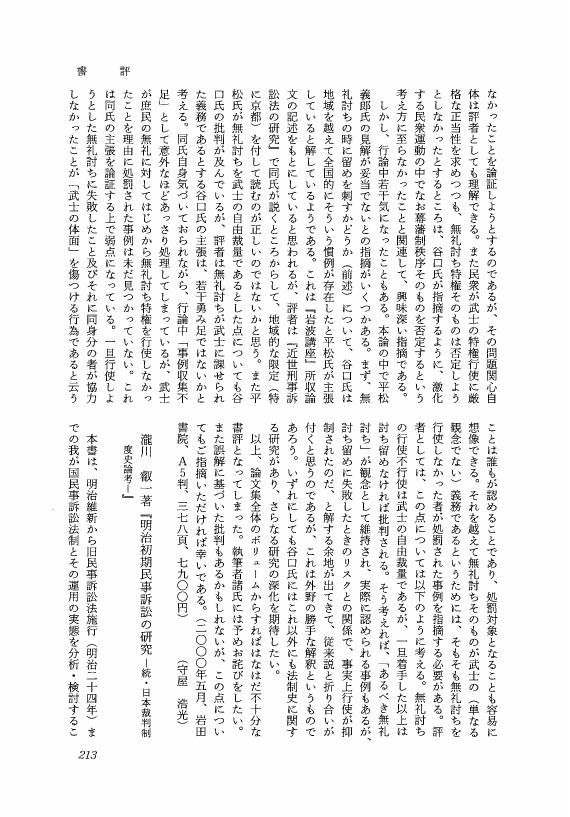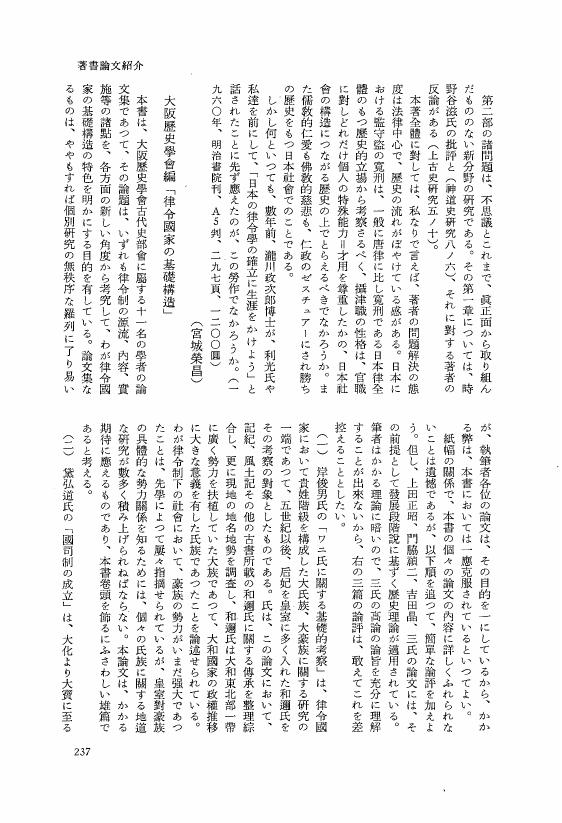1 0 0 0 OA (書評)鎌田浩著「幕藩体制における武士家族法」
- 著者
- 大竹 秀男
- 出版者
- 法制史学会
- 雑誌
- 法制史研究 (ISSN:04412508)
- 巻号頁・発行日
- vol.1972, no.22, pp.179-181, 1973-03-30 (Released:2009-11-16)
1 0 0 0 OA (書評)水戸部正男著「公家新制の研究」
- 著者
- 小林 宏
- 出版者
- 法制史学会
- 雑誌
- 法制史研究 (ISSN:04412508)
- 巻号頁・発行日
- vol.1964, no.14, pp.247-249, 1964-11-15 (Released:2009-11-16)
1 0 0 0 OA (書評)瀧川叡一著「明治初期民事訴訟の研究―続・日本裁判制度史論考―」
- 著者
- 藤原 明久
- 出版者
- 法制史学会
- 雑誌
- 法制史研究 (ISSN:04412508)
- 巻号頁・発行日
- vol.2001, no.51, pp.213-218, 2002-03-30 (Released:2009-11-16)
- 著者
- 松下 俊夫
- 出版者
- 法制史学会
- 雑誌
- 法制史研究 (ISSN:04412508)
- 巻号頁・発行日
- vol.1956, no.6, pp.260-261, 1956-03-30 (Released:2009-11-16)
- 被引用文献数
- 1
1 0 0 0 OA (書評)大阪歴史学会編著「律令国家の基礎構造」
- 著者
- 利光 三津夫
- 出版者
- 法制史学会
- 雑誌
- 法制史研究 (ISSN:04412508)
- 巻号頁・発行日
- vol.1962, no.12, pp.237-239, 1962-03-30 (Released:2009-11-16)
1 0 0 0 書評 上野史朗 中世日本の法と訴訟--落書と訴訟の関係を中心に
- 著者
- 小笠原 正仁
- 出版者
- 法制史學會
- 雑誌
- 法制史研究 (ISSN:04412508)
- 巻号頁・発行日
- no.49, pp.193-194, 1999
1 0 0 0 OA 二宮宏之著『フランス アンシアン・レジーム論―社会的結合・権力秩序・叛乱』
- 著者
- 石井 三記
- 出版者
- 法制史学会
- 雑誌
- 法制史研究 (ISSN:04412508)
- 巻号頁・発行日
- vol.58, pp.376-386, 2009-03-30 (Released:2014-03-31)
1 0 0 0 OA (書評)広中俊雄著「新版民法綱要第一巻総論」
- 著者
- 小川 浩三
- 出版者
- 法制史学会
- 雑誌
- 法制史研究 (ISSN:04412508)
- 巻号頁・発行日
- vol.2007, no.57, pp.217-220, 2007 (Released:2013-04-01)
- 著者
- 神保 文夫
- 出版者
- 法制史學會
- 雑誌
- 法制史研究 (ISSN:04412508)
- 巻号頁・発行日
- no.59, pp.282-285, 2009
1 0 0 0 OA 『古事記』への道
- 著者
- 水林 彪
- 出版者
- 法制史学会
- 雑誌
- 法制史研究 (ISSN:04412508)
- 巻号頁・発行日
- vol.1997, no.47, pp.1-62,en3, 1998-03-30 (Released:2009-11-16)
- 参考文献数
- 50
Le présent article a pour but de montrer que l'étude de la fable racontée dans le Kojiki (Le Dit des choses anciennes) constitue une tâche indispensable à la véritable compréhension de I'Etat antique japonais (Ritsuryôsei-kokka). L'ensemble, précédé d'une introduction et suivi d'une conclusion, est composé de quatre parties. Après avoir indiqué dans l'introduction l'objectif de cette étude, nous avons procédé, dans la première partie «L'Etat antique selon Ishimoda Sho», à un examen critique des travaux de ce grand historien qui ont profondément marqué l'image et la compréhension actuelles de I'Etat antique japonais pour signaler qu'il manque tout de même, dans ses élaborations, une pièce essentielle concernant l'aspect idéologique de I'Etat antique en gestation entre la fin du 7<SUP>e</SUP> siècle et le debut du 8<SUP>e</SUP> siècle. A travers l'analyse du discours prononcé en 697 par I'empereur Monmu à l'occasion de son intronisation (deuxième partie «La justification de la royauté selon la fable duKojiki »), à travers aussi celle de la grande fête Kinen pour la prospérité et la fertilité (troisième partie «La communauté cérémoniale») et, enfin, à travers la considération des divers titres accordés au roi (quatrième partie «La communauté cérémoniale et le lien roi-sujet»), nous avons mis en lumière le fait que l'arrière-fond de tout cela nest en fait rien d'autre que l'histoire mythique relatée dans le Kojiki. En somme, nous avons voulu souligner qu'il faut nécessairement se tourner vers cette oeuvre fondatrice, si l'on veut saisir I'Etat antique sous tous ses aspects. Enfin, pour terminer, un regard critique dirigé vers l'histoire des recherches sur cette période de I'histoire du Japon nous a permis de conclure à l'absence de réflexions approfondies sur la fable du Kojiki dans le champ des sciences historiques. Nous avons voulu ainsi attirer l'attention sur la nécessité de reprendre tout le dossier afin de construire une autre image de l'Etat antique japonais.
- 著者
- 山中 永之佑
- 出版者
- 法制史學會
- 雑誌
- 法制史研究 (ISSN:04412508)
- 巻号頁・発行日
- no.41, pp.p286-289, 1991
1 0 0 0 OA 古代ギリシアにおける「紛争」に対する対応の二つの側面について
- 著者
- 葛西 康徳
- 出版者
- 法制史学会
- 雑誌
- 法制史研究 (ISSN:04412508)
- 巻号頁・発行日
- vol.2000, no.50, pp.1-42,en3, 2001-04-20 (Released:2009-11-16)
This essay tries to demonstrate that there were two contrasting behaviour patterns manifest by parties faced with conflicts and disputes in ancient Greece. In one those concerned attempted to settle their differences by referring to their shared assumption of their situations and relationships involving surrounding third parties. I call this the type of sharing assumption. In the other pattern, they defied the claims of opposing party with their own contradicting interpretation of their relationships. I call it the type of defying assumption. In this latter type they often failed to reach a settlement.The method employed in this paper is to analyze the dispute scenario with particular reference to a Greek word, peitho, which is the central notion in Greek rhetoric (e.g., Plato's Gorgias), and especially the differences in implication between the middle voice peithomaj, and the active peitho.My analysis starts with the quarrel between Agamemnon and Achilleus which extends all through the Iliad. In Book 1 all the instances but one (1, 132) are in the middle voice and illustrate the assumption shared by the two parties and surrounding Achaians of their relationships in terms of the distribution of spoils. By contrast, the instances of the active peitho in Books 1 and 9 well illustrate the situation in which one party defies the assumptions of the other. Thus, I argue that their behaviour patterns provide illustrations for the two types of Greek attitude towards dispute resolution.Further references can be drawn from other scenes in Greek literature which contains countless examples of disputes and conflicts. From them I only take a few illuminating examples. I suggest that the famous carpet scene in Aeschylus' Agamemnon offers us a subtle example of the first type in a sharp contrast to the scene in the Odyssey Book 23 where Odysseus and Penelope confront each other. By contrast, the scene of Melian Dialogue in Thucydides Book 5 provides an illustration of the situation in which each party is determined to destroy the other's claim.Recent studies on Greek law have stressed context, discourse and structure for settling disputes rather than focussing on (written and unwritten) law. Indeed, it is said that Greek rhetoric contributes to magnifying the 'otherness' of Greek law. As a result I suggest that it is necessary to look at the structural patterns in which ancient Greeks dealt with conflicts and disputes. I hope that this essay will make a contribution to the understanding of Greek law and rhetoric in a much wider context.
1 0 0 0 OA キケロの「国家論」―その指導者像(二・五一)をめぐって―
- 著者
- 岡 道男
- 出版者
- 法制史学会
- 雑誌
- 法制史研究 (ISSN:04412508)
- 巻号頁・発行日
- vol.1984, no.34, pp.23-46,en4, 1985-03-30 (Released:2009-11-16)
Did Cicero intend his statesman to be understood as a 'new concept' (K. Büchner) when he called him tutor et procurator rei publicae and rector et gubernator civitatis (2.51)?Now numerous instances before and with Cicero of similar metaphors and their combinations applied to political activities make it quite clear that there is nothing new insofar as these phrases are concerned. So in view of their well-known metaphorical character 'minus......tritum sermone nostro' (2.51) should not be translated by 'not frequently used in our language i.e. Latin' but by 'not fully treated in our conversa-tion'.The study of the passages concerning the role of this statesman suggests too that it is chiefly based on auctoritas and is not appreciably different from that of the principes of the Roman republic. It is, however, very remarkable that the analogy of the reason swaying and controlling the mind, by which the imperium of a monarch is explained, seems also to have been used to describe the activities of this statesman (2.67ff.). Cicero, while conceding the superiority to the mixed form of constitution, maintains that monarchy is to be preferred to the other unmixed forms because of, among others, the fact that there will be no imperium at all unless it remains a unit. It could be inferred from this that what Cicero, when using this analogy, had in mind was a statesman who, while acting on auctoritas (2.69: ut sese......sicut speculum praebeat civibus), would be the sole leader in the state. This semi-monarchistic role is, however, clearly incompatible with the principles of the mixed form of constitution which Cicero pronounces the best and sees embodied in the Roman republic. This inconsistency, if it may be called so, could have resulted from his theorizing on an ideal statesman in line with Greek political theories while retaining him in the framework of the Roman republic.Now this statesman is set in opposition to a tyrant who is nothing but a deteriorated form of monarchy as is illustrated by the Roman history. This transformation of the best single form into the worst is most typical of all political changes. The mixed form, according to the Greek theories (mainly Polybios) outlined in the De re publica, is the most effective in maintaining equality and stability and thus preventing any change for the worse because it combines and balances the elements of the three unmixed forms; whereas Cicero sees the vital factor of stabilization in the statesman who cares for the practical interests and the self-respect of his fellow-citizens, foreseeing dangerous changes and taking necessary steps against them. Here Cicero, while following a familiar pattern of political discussions where a tyrant or tyranny is contrasted with a just king or other forms of constitution, reserves for his statesman a leading role in renewing and preserving the Roman state, and all who are present in the conversation are urged to become like him (2.45) since he is an exemplum (2.69), a model to be followed by all his fellow-citizens.The impression thus gained would be that of a 'new' statesman, but he remains nonetheless a traditional i. e. republican princeps, presented as he is in an idealized form. This method of theorizing on the traditional institutions (mos maiorum), idealizing and presenting them as exempla, is used again in the De legibus which was probably begun as soon as, or before, the De re publica was finished.It is not clear whether Augustus was influenced by Cicero's concept of this statesman. Granting that he adopted for his principate the latter's concept, then he pretended it was not new, for he emphasized his role in having restored the Roman republic and posed as a traditional princeps acting on auctoritas. In reality, however, his principate was nothing other than a kind of monarchy, a novus status, as Suetonius called it.
- 著者
- 居石 正和
- 出版者
- 法制史學會
- 雑誌
- 法制史研究 (ISSN:04412508)
- 巻号頁・発行日
- no.50, pp.309-313, 2000
- 著者
- 村上 淳一
- 出版者
- 法制史学会
- 雑誌
- 法制史研究 (ISSN:04412508)
- 巻号頁・発行日
- no.38, pp.337-342, 1988






